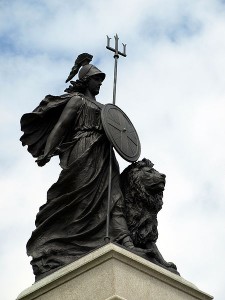Britannia is an ancient term for a title=”Great Britain” , and also a female personification of the island. The name is derives from the Greek form Prettanike or Brettaniai, which originally designated a collection of islands with individual names, including a “Albion” or Great Britain. However, by the 1st century BC Britannia came to be used for Great Britain specifically. In AD 43 the Roman began its conquest of the island, establishing a “Roman province” they called “Roman Britain” , which came to encompass the parts of the island south of “Caledonia” (roughly “Scotland” ). The native “Celts” inhabitants of the province are known as the “Britons (historical)” . In the 2nd century Roman Britannia came to be personified as a goddess, armed with a trident and shield and wearing a centurion’s helmet.
now let us look at the picture of Bharatmata. Both the goddess having Lion in common. There is no lion in europe as spacie. means picture of Beritannia also telles the great story of Migration.
____________________________________________________________________
At the end of research
Now we know that tribes like Catuvellauni and Brigantes (Sub tribe of Vindelici ) reached there. Now we know that They have roots in Katarmal sun temple and its deity ” Burhadita or Vraddhaditya “. There is No doubt…. Goddess Britannia stands for Bharatmata. After all they were Sanatan defenders of Gate way of India.
The following link about Brigantes tribe will tell you complete story.
Brigantes
The Brigantes were a Celtic tribe who in Pre Roman times controlled the largest section of what would become Northen England, and a significant part of the Millands. Their kingdom is sometimes called Brigantia, and it was centred in what was later known as Yorkshire. Ptolemy lists the Brigantes also as a tribe in Ireland, where they could be found around wexford, Kilkeny and waterford while another probably Celtic tribe named Brigantii is mentioned by Strabo as a sub-tribe of the Vindelici in the region of the Alps.
Within Graet Britain, the territory which the Brigantes inhabited was bordered by that of four other Celtic tribes: the Carvetii (to whom they may have been related) in the North-West, the Parisii to the East and, to the South, the Corieltauvi and the Cornovii. To the North was the territory of the VOtadini, which straddled the present day border between England and Scotland.
The name Brigantes is cognate to that of the goddess Brigantia. The name is from a root meaning “high, elevated”, and it is unclear whether settlements called Brigantium were so named as “high ones” in a metaphorical sense of nobility, or literally as “highlanders”, referring to the Pennines, or inhabitants of physically elevated fortifications. ( “bhereg’h-“).
In modern Welsh the word braint means ‘privilege, prestige’ and comes from the same root brigantj?. Other cognates from the modern Celtic languages are: Welsh brenin ‘king’ (< *brigant?nos); Welsh/Cornish/Breton bri 'prestige, reputation, honour, dignity', Scottish Gaelic brìgh 'pith, power', Irish brí 'energy, significance', Manx bree 'power, energy' (all < *br?g-/brigj-); and Welsh/Cornish/Breton bre 'hill' (< *brig?). The name Bridget from Old Irish Brigit (Modern Irish Bríd) also comes from Brigantja, as does the English river name Brent.
There are several ancient settlements named Brigantium around Europe, such as Berganza in Alva (Spain), Betanzos and Bergondo in Galicia (Spain), Braganca in Portugal and Briancon and Bregenz in the Alps.
Link





